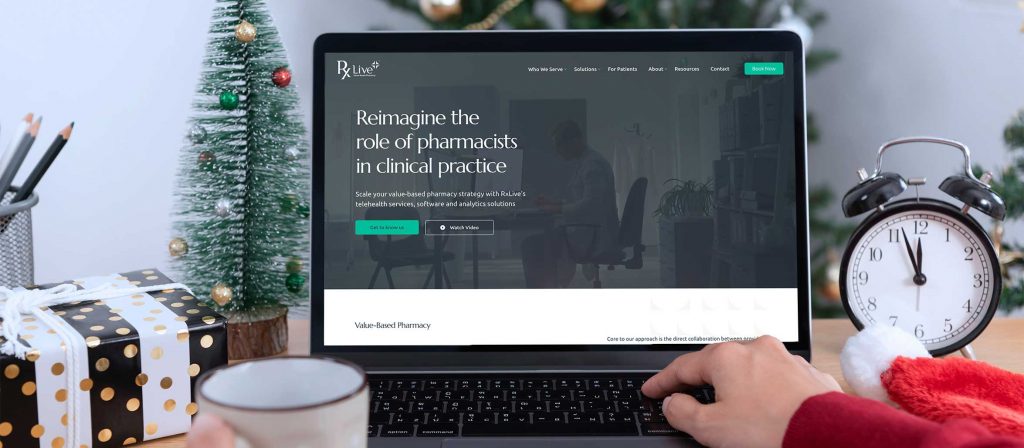Celebrating AmCare clinical pharmacy innovations and pharmacists across the country
Did you know 25% of neighborhoods in the United States don’t have a pharmacy? Research shows that this reality often inhibits medication access.
And when patients can access the medications they need, the cost of their prescription drugs is often outrageous (and prohibitive).
Medication-based care in the United States is, in a word, inequitable.
We need change.
In this month’s edition of The Collaborative Practice, RxLive dives into pharmacy-related health inequity to explore how data and telemedicine can help make equitable community-focused care possible for everyone.
All the best –
The Team @ RxLive

Meet RxLive at HLTH!
Join our Co-founders, Mark and Kristen, at the upcoming HLTH Conference to explore:
- Enhancing ACO Performance
- Unlocking Value-Based Pharmacy
- Previewing a QHIN Collaboration
Let’s dive into healthcare’s future together!
Hope to see you there!
A data-driven path to more equitable population-level care
When patient-centered teams work to keep people healthy rather than care for the sick it results in better population-level health. What’s more: it’s in large part why we founded RxLive.
And that’s why we were so excited to sit down with population health management expert Karen Handmaker to discuss how physician-led teams address the social determinants of health that influence how patients attain their best possible outcomes.
Achieving health equity in the United States is more than a noble goal. As part of the “Quintuple Aim,” it’s a key way for clinicians to offer more valuable care to the most vulnerable patients.
But it’s an initiative that requires all of us because, as Karen puts it, “the more hands on deck, the more actionable information we get.”
Watch the full interview – and learn how data can make it easier for governmental and community partners to deliver healthy resources to everyone – here.
And if you’d like to join the conversation, please get in touch.
Value-expanding webinars, interviews, and more
Eager to learn more after Karen’s conversation? Explore more interviews – along with the Value Expansion webinar archives – on our blog.
The case for pharmacist intervention
In each edition of The Collaborative Practice, we highlight one anonymized patient case from a pharmacist in our network. The goal? Illustrate the value of pharmacist interventions and the benefits they deliver throughout the healthcare ecosystem. Here’s our case for this month…
Patient case: Supporting equitable medication access through price assistance
Recently, one of our pharmacists met with an 87-year-old female with type 2 diabetes (T2D).
- Current medications: Levemir; at last Ac1 check, medication was increased due to the patient not being at goal.
The patient’s chart showed Jardiance had been previously recommended but not prescribed due to being cost prohibitive. After researching the patient’s formulary, our pharmacist found that both SGLT2i Farxiga and Jardiance are covered medications and, if using mail order, may be available to the patient at no cost. This information was provided to the patient along with details about patient assistance programs for each medication that the patient may qualify for. The pharmacist then recommended the provider move forward with prescribing either SGLT2i to support a reduced A1C, CV risk reduction, and to help prevent the progression of diabetic kidney disease.
Stories we’re following
From consumer preferences for value-based care to Medicare price negotiations, here are five topics we’re following this month:
An overdose drug is finally over-the-counter. Is that enough to stop the death toll?
Naloxone, sold as a nasal spray under the brand name Narcan, is now for sale in retail pharmacies. But more education is needed to help overcome supply and price hurdles that experts worry will limit the drug’s population-level effectiveness.
Biden administration to ban medical debt from Americans’ credit scores
New regulations would, if enacted, eliminate unpaid medical bills from the credit reports of tens of millions of people – a big step to support better health equity.
Online pharmacy programs can save patients millions in prescription drug costs, study finds
A study published in the Annals of Internal Medicine finds that online pharmacy discount programs have the potential to save patients money on prescriptions compared to drugs purchased through traditional insurance plans.
Physical rehabilitation interventions could aid individuals with post-COVID-19 condition
It’s believed cases of post-COVID-19 condition (PCC) are increasing due to undocumented cases of COVID-19 infection. According to research published in JAMA Network, exercise after an initial period of rest may be key to recuperation.
Uncle Sam wants you – to fight high drug prices
Medicare is building a team of economists, data scientists, and pharmacists to begin drug-price negotiations. The goal: reform the $400 billion prescription drug market and lower the cost of medication-based care.
41 facts for the spookiest time of year
Honing your knives to carve Jack-o’-lanterns? Love pumpkin-spiced…everything? With Halloween just around the corner, we – and especially our kids! – are excited, too.
We know, some spend October debating the virtues (or lack thereof) of candy corn. Others become consumed with whether The Last of Us or Barbie presents this year’s best costume.
But no matter where you focus your Halloween enthusiasm, we’re confident you’ll find a satisfying trick or treat in this list of 41 Halloween facts.
Here’s a sickly-sweet preview: candy corn was originally called “chicken feed.”





